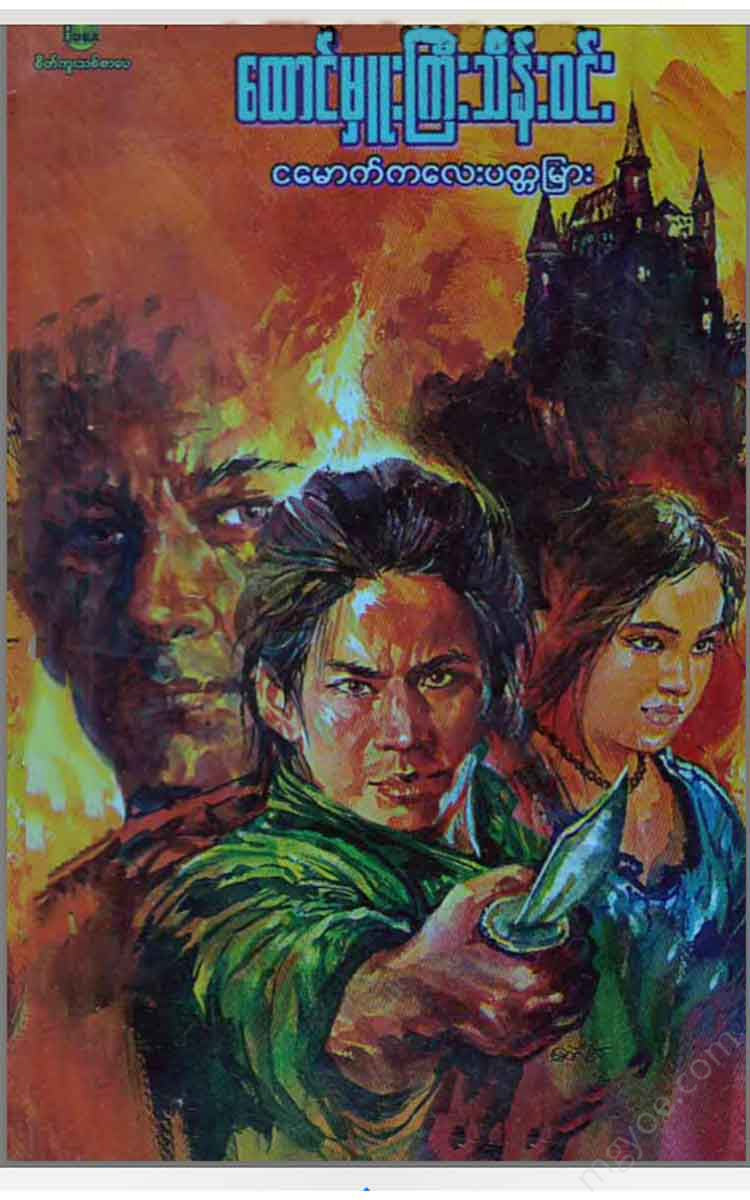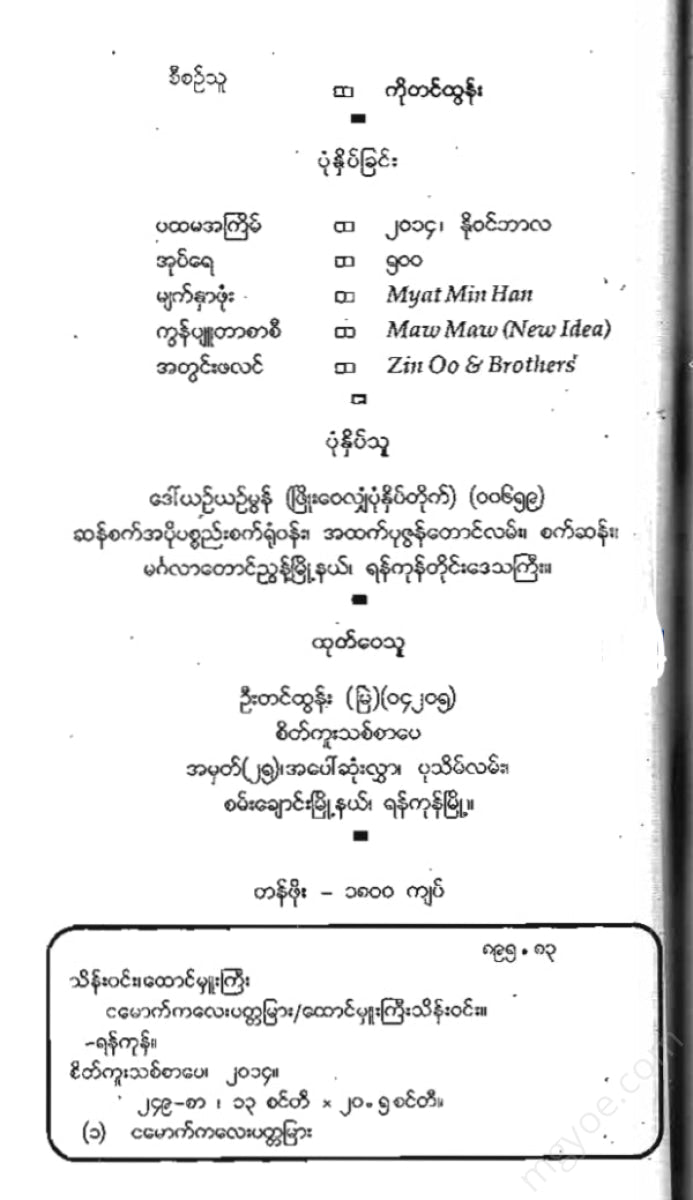Other Websites
Prisoner Thein Win - Ngamaukkale Ruby
Prisoner Thein Win - Ngamaukkale Ruby
Couldn't load pickup availability
Chapter (1)
Our village is called Thayet Taw Village. There are about 400 households in the village, so it is a large village. (6) The village chief, U Lu Maung, has been a chief since the British era and has been a chief for generations. There is a large two-story wooden house in the middle of the village. My father is the youngest brother of Chief U Lu Maung and lives in a large two-story house in the middle of the village. My father and mother have been members of a chief family for generations and are wealthy.
We are a family of three, and I, Maung Tauk Htein, am the only son. We have about 110 acres of land and more than 20 cows. There are only four or five of us in Thayet Taw village, and my parents are among the wealthy people with the title of Tow Thay.
However, our village is more than (30) miles away from Taungoo town and more than (5) miles away from the Yangon-Mandalay highway. Therefore, although we are financially rich, we cannot pursue higher education. Since I am the only child, although I am financially rich, my parents do not allow me to go to the city and study higher education.
Therefore, in the monastery east of our village, under the guidance of U Pyin Sin U Zawana (now the abbot of the monastery), U Pyin Sin U Zawana taught religion, geography, history, English, mathematics, and the skills of horse riding, swimming, martial arts, and wrestling that men were required to learn, just as the monks of the ancient times taught.
I was a student of U Pyin Sin U Zawana and excelled in martial arts more than other students. In addition, my father arranged for me to study with famous martial artists in addition to my hobby, so I am very good at all Burmese martial arts, Shan martial arts, and boxing. Therefore, even in my youth, I was almost an expert in martial arts. Because of my hobby, I trained every day with my friends from the cattle school, Moe Kyaw Shwe Ni, Shwe Wah brothers Kyaw Htun, Tin Htun, and Lay Maung.
There is a large cemetery (5 acres) near our village. Although it is surrounded by nearby villages such as Kyaw Pin Kone, Pauk Pin Village, Zarat Kwin, Slu Ai, Myin Kha Kone, and Htein Pin Village, it is called Thayet Taw Village Cemetery because it is close to our village.
The cemetery is surrounded by large mango trees, tamarind trees, and sycamore trees. It is a very peaceful place. Although it is 5 acres in size, about 20 tombs, gravestones, and maps are buried in the southern part of the cemetery.
The cemetery has only a large stone and mortared roof, a large shrine for the burial, but not far to the east of the shrine is a large meditation temple on the edge of the cemetery. The donor of the temple was an unknown rich man from Shan State. It is known that the temple was built in honor of the forest monk he worshipped.
“That monk also passed away after only a year of sitting alone in the monastery, so the monastery was closed. It is known that the monastery has been abandoned for more than 50 years because other monks did not practice meditation.
The school was built with high-quality teak and pine wood, so it was not damaged by the weather, but bird droppings fell on the roof tiles, and the bamboo shoots, cocoyam shoots, tamarind shoots, and other small trees grew on them, causing the tiles to rot.
Under the bridge, termite mounds have formed, and in the schoolyard, a dense forest of wild plants such as mya ya chung, sibuya, yarrow, sambucus nigra, and other wild plants has formed.
The village cemetery is actually (5) acres in size, but the graves and burial plots are only about one-fifth of the cemetery, and the rest is covered with trees and grass. There is a large lake near the cemetery, but since it is a cemetery lake, people do not use it. It is just a big pond where cattle drink water. The grazing land where we raise cattle is only the cemetery land. It is about three acres in size. The five-acre cemetery is surrounded by the farmlands of our Thayet Taw village and the nearby villages of Kyaw Ping Kone, Pauk Ping, and Zaryat Kwin.
The cemetery is adjacent to a cattle pasture, but the owners of the adjacent farmland have not encroached on the cemetery even a single foot. This is because the person who donated the cemetery had placed a stone pillar near the cemetery and cursed anyone who encroaches on the five acres of cemetery land to die. Therefore, despite the passage of time, the cemetery has remained as it was. Inside the cemetery, there are large kukkos, tamarinds, and mango trees that are about three feet wide. These trees are freely available for people from the surrounding villages to pick and eat.
Our group of cowherds would bring the cows out of the cowsheds at around 6am and spread the graves, while we would eat, drink and play on the ground and on the graves under the shade of a large sycamore tree. The cowherds would each carry a sack of hay, a cane and a pack of rice. They would also carry water bottles and packed lunches.
In the morning, after turning the cows in the cowshed, a group of my friends and I started playing games in the cowshed. We played games such as Lauk Khwari Htuttan and Napanchatat. In Lauk Khwari Htuttan, we each had to hit the letter of the chosen letter with a hammer.
Some people use stones to make the letters and cover them with clay. Others use clay to make the letters and cover them with clay. This is done to prevent them from breaking. The letters that are made with stones to make the letters are heavy, while the letters that are made with clay to make the letters are light. Our letters are made of clay that is collected from the village's drinking pond, kneaded, and shaped to your liking.
When playing the game of Lauk Shwartha, the winner must give (50) or (100) Lauk Shwartha to the winner and the loser must give (50) or (100) Lauk Shwartha to the loser. For us cowherds, each person spends at least (50) or (100) Lauk Shwartha per day. It is spent by throwing them at distant cows and throwing mangoes and tamarinds in the cemetery. In addition, if you play the game of Lauk Shwartha by rolling the Lauk Shwartha, you can also lose money and win.
Money is not something we students use or use often. We only eat and drink the lunches, rice packets, and snacks provided by our home, and we save the water bottles we bring with us to drink.
I will tell you about it. As I said before, the most important thing for us cowherds is the number of letters and the number of letters. When I play the number of letters (dun) I usually win. Because I have a secret.
The common lauk-khor are made by scooping mud from the village drinking pond and kneading it until smooth, so the clay used to make the lauk-khor is the same. To prevent the lauk-khor from breaking, you need good clay. The secret I mentioned earlier is that clay.
My lakshmi is not picked from the village pond and rolled. I pick the mud from the big pond near the cemetery and roll it as I like. I only dry it for a day in the sun. The lakshmi that is often dried in the sun is too dry and light in weight. It breaks easily when hit.
The mud in the cemetery is very thick and black. Not many people can go into the cemetery pond. It is not because the water is deep. The large buffaloes in the pond are about an inch deep and have a very good blood sucking ability. Not to mention people, even cattle cannot stand it and have to run away.
I have a trick. Before going down into the pond, I apply a mixture of lime and tobacco to my feet. When I go down into the pond, the big, soft buffaloes don't even come close to people and stay far away. That's why I'm the only one who can dig the very sticky clay in the cemetery pond.
There is another thing. For us, the most important tool for the cowherds is the slingshot. That is why we make the best slingshots and hold them. In making the slingshots, we take time to shape them using tamarind pulp, yam pulp, cow horns, and buffalo horns, using a sharp knife and a broken bottle to create the shape we want.
The leather for the sling is selected from a type of leather that can be used by a person holding a single or double sling. The slingshot case, which is used to insert the slingshot, is made of cowhide or goathide. Goathide is very thin and soft. Cowhide is fine.
When making a letter envelope, you need to choose the right size for the letter you are using, not too big or too small, so that the letter runs straight where you want it. The size of the letter is also a size that you are skilled at and can handle, and it is very important to have a perfectly round and smooth shape.
Another important thing is to choose the tamarind pulp. The tamarind pulp is not easy to break when it is pressed together, but it is not smooth and rough when it is shaped. The color is not beautiful. The pulp is black. Very beautiful. It is very hard to handle when it is pressed.
Making a buffalo horn slingshot is quite a skill. It takes a lot of patience to get the slingshot that the owner needs. First, find a good buffalo horn for making a slingshot. Cut the desired size, with a sharp tip and a hollow base, and insert the buffalo horn into the center of a banana block. Then, the banana block is placed on a fire with a piece of wood and baked. - Then, the banana juice cooks the buffalo horn, making the buffalo horn soft. Then, cut it with a sharp knife and shape it. The buffalo horn is very hot, so the worker is careful to handle it before it loses heat. As the heat gradually decreases, the buffalo horn hardens.
Since it is made at that time, only an expert can do it quickly. The same method is used for making cow horns. However, because cow horns are rough and short, they are not as good as buffalo horns when it comes to making the long horns. They are not beautiful, but the long horns called the long horns of the buffalo are very beautiful and famous.
That day we played as usual. At noon, we opened the rice packets we had brought and ate on the graves under the shade of the big Kukko tree in the cemetery. Then we went to look at the cows. At that time, the cows were let out to pasture.



